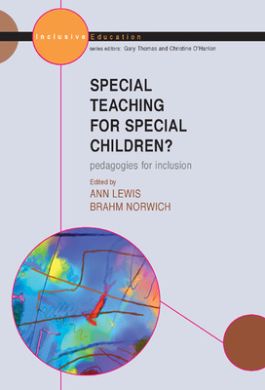Special Teaching for Special Children? Pedagogies for Inclusion
Receive via shipping:
- Colour, print bound version of the complete text
Chapter 1
How specialised is teaching pupils with disabilities and difficulties? - Brahm Norwich and Ann Lewis
Chapter 2
Deafness - Sue Gregory
Chapter 3
Visual impairment – Graeme Douglas and Mike McLinden
Chapter 4
Deafblindness - Olga Miller and Liz Hodges
Chapter 5
Severe Learning Difficulties - Jill Porter
Chapter 6
Profound and Multiple Learning Difficulties - Jean Ware
Chapter 7
Children with Down’s Syndrome - Jennifer Wishart
Chapter 8
English as an additional language and children with speech, language and communication needs - Deirdre Martin
Chapter 9
Autistic spectrum disorders - Rita Jordan
Chapter 10
AD/HD - Paul Cooper
Chapter 11
Dyslexia - Gavin Read
Chapter 12
Dyspraxia - Madeleine Portwood
Chapter 13
Social, emotional and behavioural difficulties - Tim O’Brien
Chapter 14
Moderate Learning Difficulties - Felicity Fletcher-Campbell
Chapter 15
Low attainment - Alan Dyson and Peter Hick
Chapter 16
Overview and discussion: overall conclusions - Ann Lewis and Brahm Norwich
Educational Review
- What, if anything, is ‘special’ about teaching children with special or exceptional learning needs?
Some special needs groups (for example dyslexia) have argued strongly for the need for particular specialist approaches. In contrast, many proponents of inclusion have argued that ‘good teaching is good teaching for all’ and that all children benefit from similar approaches. Both positions fail to scrutinise this issue rigorously and coherently, and it is this aspect which distinguishes this book.
Leading researchers in each special needs field defend and critique a conceptual analysis of teaching strategies used with particular learner groups with special educational needs. Summaries by the editors after each chapter link pedagogic strategies, knowledge and curriculum to key points from the chapter and pave the way for discussion.
This book is indispensable reading for students, policy makers, researchers and professionals in the field of special educational needs and inclusion.
Shortlisted for the TES / NASEN Book Awards 2005

